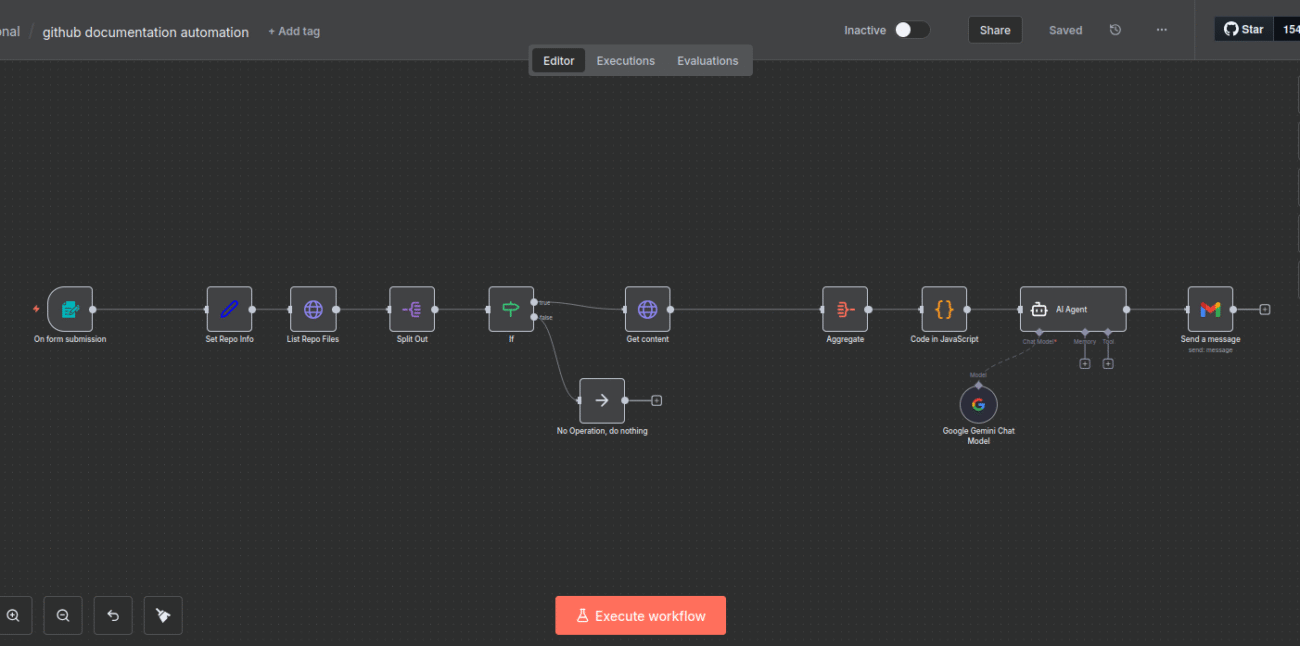Main Dish (Idea): The Automated GitHub Documentation Feast
This digital delicacy transforms any GitHub repository into a gourmet recipe of words. It’s a smart workflow that fetches the project’s source code, cooks it through AI interpretation, and serves up a flavorful written description — all automatically. The dish takes raw repo ingredients and turns them into a ready-to-eat story that captures the project’s essence.
Ingredients (Concepts & Components):
- 🧾 Form Trigger (On Form Submission): The waiter taking the order — it starts the process when you provide a GitHub repo name.
- 🧂 Set Repo Info: Prepares the base flavor by defining the owner, repo name, and branch.
- 🍳 HTTP Requests (List Repo Files / List Repo Files1): These are the sous-chefs fetching ingredients from GitHub — the files, paths, and content of the project.
- 🔪 If Node: The quality control chef, ensuring only useful ingredients (.py, .ipynb, .md files) make it to the dish.
- 🧩 Split Out & Aggregate: The mixing bowl — separates, collects, and combines all data into a cohesive batch.
- 🧠 Code Node (JavaScript): Decodes the base64-encoded content, preparing the raw text for AI processing.
- 👨🍳 AI Agent (LangChain + Gemini): The head chef — interprets the project’s flavor and writes it as a recipe-style summary using AI.
- 📬 Gmail Node: The server plating the final dish and sending it to the guest’s inbox, hot and ready.
Cooking Process (How It Works):
- Order Received: The workflow starts when someone enters a repo name into the form.
- Gather Ingredients: The repo owner, name, and branch are defined and passed to GitHub’s API.
- Ingredient Collection: The HTTP request nodes fetch the file tree, recursively collecting every file in the repository.
- Selective Sampling: The “If” node filters files — only Python, Markdown, and Jupyter Notebook files are considered (the meaningful spices).
- Extract and Prepare: Each selected file’s raw content is pulled, decoded, and combined into a single, digestible mixture of code and documentation.
- Cooking with AI: The aggregated text is fed to the AI Agent powered by LangChain and Google Gemini. The agent interprets the project, describing it as if it were a chef preparing a meal — complete with main dish, ingredients, and cooking steps.
- Serving the Dish: The final output — a polished “recipe” of the project — is automatically emailed to the specified address.
Serving Suggestion (Outcome):
When perfectly cooked, this workflow produces a beautifully written “recipe” that explains what a GitHub project does, how it works, and what ingredients it uses — all delivered straight to your inbox. It’s automation served with creativity: a seamless blend of GitHub data extraction, intelligent processing, and poetic presentation.
In short, it’s an AI kitchen that turns code into cuisine — transforming dry repositories into delicious stories.


